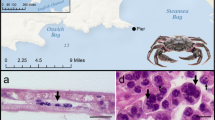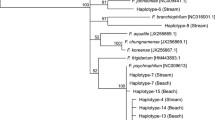Abstract
Blue crab, Callinectes sapidus, commercial landings in the USA have been declining at an alarming rate. In South Carolina, these declines are significantly correlated with years of decreased rainfall and elevated salt marsh salinity. Previous studies suggest that higher salinity increases the risk of infection by Hematodinium sp., a dinoflagellate parasite of blue crabs, C. sapidus. A 4-year survey (June 2008 to March 2012) of blue crabs in the ACE Basin National Estuarine Research Reserve documented (1) the temporal and spatial patterns of Hematodinium sp. infection in relation to salinity, (2) some environmental correlates of disease prevalence, and (3) the characteristics of infected blue crabs. Sampling was conducted four times a year in March, June, September, and December in the South Edisto, Ashepoo, and Combahee rivers beginning in June 2008. Crab hemolymph samples were collected and preserved and DNA was successfully amplified for 2,303 individuals. Hematodinium sp. infection was evaluated by PCR amplification of its 18S rRNA gene and adjacent regions. Prevalence was highest in December 2008 in the Combahee River at sites closest to St. Helena Sound. The spatial and temporal pattern of Hematodinium sp. infection was correlated with several environmental parameters. Infected crabs exhibited differences in carapace shape and body condition compared to uninfected crabs. Overall, these results suggest that blue crabs in regions of higher salinity are at greater risk of infection by Hematodinium sp. and infected individuals exhibit sub-lethal effects of the disease.






Similar content being viewed by others
References
Atlantic States Marine Fisheries Commission. 2004. Status of the blue crab (Callinectes sapidus) along the Atlantic coast. Special scientific report no. 80.
Childress, M.J. 2010. Modeling the impact of drought on South Carolina blue crabs using a spatially-explicit individual-based population model. SC Water Resources Conference Proceedings, Columbia, SC.
Frischer, M.E., R.F. Lee, M.A. Sheppard, A. Mauer, F. Rambow, M. Neumann, J.E. Brofft, T. Wizenmann, and J.M. Danforth. 2006. Evidence for a free-living life stage of the blue crab parasitic dinoflagellate, Hematodinium sp. Harmful Algae 5: 548–557.
Gruebl, T., M.E. Frischer, M. Sheppard, M. Neumann, A.N. Maurer, and R.F. Lee. 2002. Development of an 18S rRNA gene-targeted PCR-based diagnostic for the blue crab parasite Hematodinium sp. Diseases of Aquatic Organisms 49: 61–70.
Lee, R.F., and M.E. Frischer. 2004. The decline of the blue crab. American Scientist 92: 548–553.
Li, C., J.D. Shields, T.L. Miller, H.J. Small, K.M. Pagenkopp, and K.S. Reece. 2010. Detection and quantification of the free-living stage of the parasitic dinoflagellate Hematodinium sp. in laboratory and environmental samples. Harmful Algae 9: 515–521.
Messick, G.A. 1994. Hematodinium perezi infections in adult and juvenile blue crabs Callinectes sapidus from coastal bays of Maryland and Virginia, USA. Diseases of Aquatic Organisms 19: 77–84.
Messick, G.A., and J.D. Shields. 2000. Epizootiology of the parasitic dinoflagellate Hematodinium sp. in the American blue crab Callinectes sapidus. Diseases of Aquatic Organisms 43: 139–152.
Messick, G.A., S.J. Jordan, and W.F. Van Heukelem. 1999. Salinity and temperature effects on Hematodinium sp. in the blue crab Callinectes sapidus. Journal of Shellfish Research 18: 657–662.
Parmenter, K.J. 2012. The effects of drought on the abundance of the blue crab, Callinectes sapidus, in the ACE Basin NERR in South Carolina. PhD dissertation. Clemson University.
Sheppard, M.A., A. Walker, M.E. Frischer, and R.F. Lee. 2003. Histopathology and prevalence of the parasitic dinoflagellate, Hematodinium sp, in crabs (Callinectes sapidus, Callinectes similis, Neopanope sayi, Libinia emarginata, Menippe mercenaria) from a Georgia estuary. Journal of Shellfish Research 22: 873–880.
Shields, J.D., and C.M. Squyars. 2000. Mortality and hematology of blue crabs, Callinectes sapidus, experimentally infected with the parasitic dinoflagellate Hematodinium perezi. Fisheries Bulletin 98: 139–152.
Small, H.J., J.D. Shields, K.L. Hudson, and K.S. Reece. 2007. Molecular detection of Hematodinium sp. infecting the blue crab, Callinectes sapidus. Journal of Shellfish Research 26: 131–139.
Stentiford, G.D., and J.D. Shields. 2005. A review of the parasitic dinoflagellate Hematodinium species and Hematodinium-like infections in marine crustaceans. Diseases of Aquatic Organisms 66: 47–70.
Whitaker, J.D., L.B. DeLancy, J.E. Jenkins, and M.B. Maddox. 1998. A review of the fishery and biology of the blue crab, Callinectes sapidus, in South Carolina. Journal of Shellfish Research 17: 459–463.
Wilber, D.H. 1994. The influence of Apalachicola River flows on blue crab, Callinectus sapidus, in north Florida. Fisheries Bulletin 92: 180–188.
Zohar, Y., A.H. Hines, O. Zmora, E.G. Johnson, R.N. Lipcius, R.D. Seitz, D.B. Eggleston, A.R. Place, E.J. Schott, J.D. Stubblefield, and J.S. Chung. 2008. The Chesapeake Bay blue crab (Callinectes sapidus): A multidisciplinary approach to responsible stock replenishment. Reviews in Fisheries Science 16: 24–34.
Acknowledgments
We would like to thank Margaret Ptacek, Tim Jordan, Joe Bisesi, and Aaron Lauritson. We thank Daniel Barrineau and Dr. Al Segars for assistance with logistics and use of the McKinzie Field Station. Karrie Brinkley and Dr. Dick Lee provided valuable reference samples and guidance during development of our PCR protocols. Kristine Moody and Dr. Margaret Ptacek graciously shared their time, expertise, and laboratory equipment. This field work was conducted with the permission of the ACE Basin National Estuarine Research Reserve and the SC Department of Natural Resources (permit # EX09-0004, EX10-0076, and EX11-0068). This article is a result of work sponsored by the South Carolina Sea Grant Consortium with support from NOAA National Sea Grant College Program, U.S. Department of Commerce, Grant No. 2010-R/CF 15 (MJC). Student participation was supported by a Clemson University Creative Inquiry Grant (MJC), a Calhoun Honors Research Grant (CKM and JAM), and a Wade Stackhouse Graduate Fellowship (KJP). This research was conducted under an award from the Estuarine Reserves Division, Office of Ocean and Coastal Resource Management, National Ocean Service, National Oceanic and Atmospheric Administration.
Author information
Authors and Affiliations
Corresponding author
Appendix
Appendix
Rights and permissions
About this article
Cite this article
Parmenter, K.J., Vigueira, P.A., Morlok, C.K. et al. Seasonal Prevalence of Hematodinium sp. Infections of Blue Crabs in Three South Carolina (USA) Rivers. Estuaries and Coasts 36, 174–191 (2013). https://doi.org/10.1007/s12237-012-9556-1
Received:
Revised:
Accepted:
Published:
Issue Date:
DOI: https://doi.org/10.1007/s12237-012-9556-1




